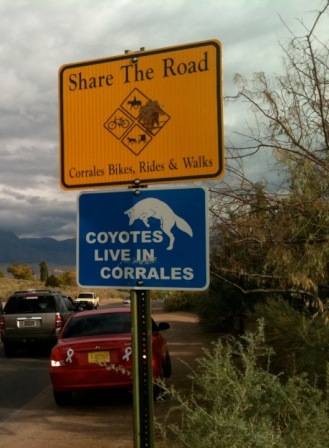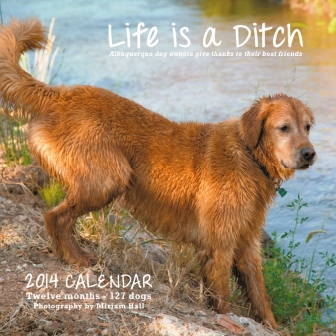
Corrales loses its 'coyote lady'
Susan Weiss thrust Village into forefront
for wildlife management
Albuquerque lost a pioneering advocate for wildlife in November when Susan Weiss succumbed to a three-year battle with lung cancer. She was 75. Long known as “the coyote lady” in Corrales, where she lived for three and a half decades, Weiss was largely responsible for transforming attitudes in the Village as it evolved rapidly from rural to suburban.
Galvanized by perceived abuses in animal control, she mounted what became an exhaustive campaign in 2001 that culminated in passage of the Corrales Coyote Management Plan, a model of humane wildlife management in New Mexico.
In 2002 she received a Milagro Award from Animal Protection of New Mexico for animal advocacy. Even a decade later, however—long after the Village had institutionalized a coyote management policy focused on preventing predation, rather than on extermination—Weiss saw the constant threat of a return to practices rooted in a frontier mentality.
Petite and unassuming, she was well known around Corrales not only for her frequent appearances at Village Council meetings and regular letters to the editors of the Corrales Comment and Albuquerque Journal, but also for her long walks on the mesa and in the bosque. She studied coyote movements and kept close tabs on family groups and dens.
Marshalling scientific data, testimony from national experts, and volunteers enlisted through grassroots organizing, Weiss made a disarming adversary for those who defended such longstanding traditions as hunting coyotes with hounds, or shooting them on sight.
Over the years she built up a cadre of volunteers who would help her “haze,” or train coyotes to avoid humans. Through her efforts, Corrales became known for its science-based approach to coyote management, after years of gassing or drowning pups in their dens.
“Mother’s interest was both—taking care of animals, and the scientific approach,” said her daughter, Deborah Weiss. At one point Susan undertook a study of coyote scat, collecting and analyzing samples, much to the puzzlement of Corrales old-timers.
Born in New Jersey, Susan Feldman Weiss had a lifelong love of animals that began with the family cats. In college she majored in biology and English, interests she maintained all her life. After marrying Stephen Weiss, she helped support him through dental school at the University of Pennsylvania by working as an assistant at an electron microscopy lab. She later worked as a technical editor.
The couple moved constantly in the 1960s and ’70s, when he served as a dental officer in the Indian Health Service. With son Andrew and daughter Deborah, the Weisses lived on Indian reservations throughout the West before settling in Corrales in 1976.
Their family life centered around outdoor recreation and observing nature, according to Stephen and Deborah. Susan “was always rescuing birds,” her daughter said. “She was always the ‘bird lady’ everywhere we lived, and we had an assortment of wild birds at home that could not be rehabilitated,” including a pigeon and a grosbeak. “She wouldn’t tolerate the killing of any insect,” her daughter added. “She loved little creatures.”

Upon
learning of abuses in coyote treatment, and getting no response from
the Corrales council or mayor, Weiss mounted a campaign in 2001 that
grew to include petitions, letters to the editor, taking ads in local
publications, and asking real estate agents to educate newcomers about
coyotes. Her efforts led not only to the Corrales Coyote Management
Plan, but also to the nonprofit Coexist with Coyotes, and the “Coyotes
live in Corrales” signs at entrances to the Village (since removed). She
was for years a certified wildlife rehabilitator with the nonprofit
group Fur and Feathers.
Unfailingly polite and gracious, Weiss achieved her ends through a
dogged tenacity rather than aggression. “When she had a commitment, she
would be at it day and night,” Stephen said. “She wanted to move
people’s attitudes, and I think in that she was successful.”
Susan Weiss is also survived by son Andrew Weiss, brother Peter
Feldman, and granddaughters Jordan Weiss and Louise Whiting. A memorial
fund has been established to continue her work promoting coexistence
with coyotes. Donations can be made online at ProjectCoyote.org—please earmark in comments for the Susan Weiss Coyote Coexistence Memorial Fund.
Critical time for carnivores
As
we went to press, the U.S. Fish and Wildlife Service was taking public
comments on proposed rule changes affecting the Mexican wolf and its
larger cousin, the Gray Wolf. The agency proposes removing the Gray Wolf
from Endangered Species Act protections, arguing that wolves have
rebounded to the point that they may be hunted. At the same time it
would add the subspecies Mexican wolf to the endangered list and expand
the area in New Mexico where captive-bred wolves can be released into
the wild.
Mexican wolves are the smallest, rarest, most genetically distinct
subspecies of the Gray Wolf. they were virtually exterminated by
shooting and trapping by 1970. Captive-bred wolves were reintroduced
into the Apache National Forest in Arizona and Gila National Forest in
New Mexico starting in 1998, but the population has grown to only 75
over those 15 years, from a goal of 100 wolves by 2006. at least 46
wolves have been shot illegally.
Under the proposed rule change, Mexican wolves could be released into
the whole wolf recovery area in southern New Mexico and Arizona— but
they would continue to be trapped and relocated if found outside that
area, such as in the rich habitat around Four Corners.
Wildlife biologists and wolf advocates say that will keep the Mexican
wolf population from reaching a sustainable size. They maintain that
wolves need larger, better habitat to rebound successfully, and that
relocated wolves rarely survive to establish family groups in new areas.
Meanwhile, the proposal to delist the Gray Wolf (found in northern
states) has come under intense fire from wildlife advocates. Lobbying by
ranching and hunting interests, funded by the billionaire conservative
Koch brothers, has legalized wolf hunting in the last two years in
Idaho, Montana, and Wyoming. Last season, at least 550 wolves were
killed in the Northern Rockies.
The Fish & Wildlife service was to hear public comment on rule
changes concerning both wolves in Albuquerque on Nov. 20. The agency is
taking public comment online through Dec. 17 at www.regulations.gov. A decision will likely be made in early 2014.
* * *
THE INTEREST IN blood sports involving wildlife continues, both in New
Mexico and nationwide. After coyote and prairie dog killing sprees last
year sponsored by local gun retailers, a number of contests are set for
the near future, prompting wildlife advocates to rally in protest at the
university of New Mexico on Nov. 16.
A contest called by Guns and Gold Pawn Shop in
Los Lunas was set for that weekend, with proceeds to benefit a
children’s charity. Children are frequently brought along on wildlife-
killing sprees, and have been photographed triumphantly standing on
carcasses—presumably as a valuable learning experience.


